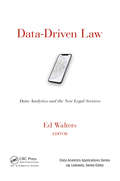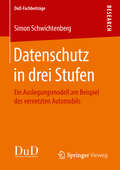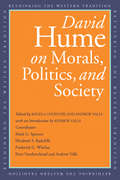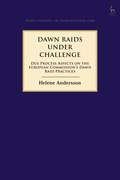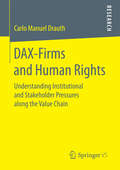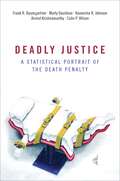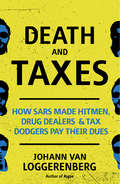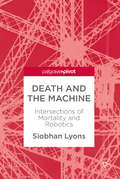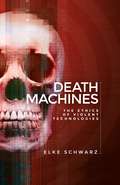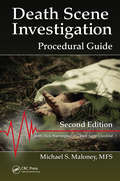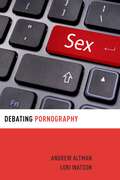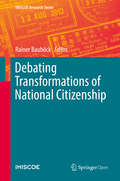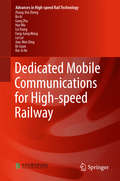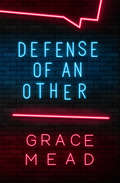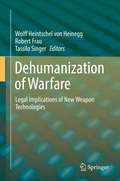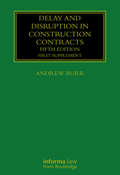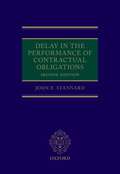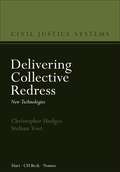- Table View
- List View
Data-Driven Law: Data Analytics and the New Legal Services (Data Analytics Applications)
by Edward J. WaltersFor increasingly data-savvy clients, lawyers can no longer give "it depends" answers rooted in anecdata. Clients insist that their lawyers justify their reasoning, and with more than a limited set of war stories. The considered judgment of an experienced lawyer is unquestionably valuable. However, on balance, clients would rather have the considered judgment of an experienced lawyer informed by the most relevant information required to answer their questions. Data-Driven Law: Data Analytics and the New Legal Services helps legal professionals meet the challenges posed by a data-driven approach to delivering legal services. Its chapters are written by leading experts who cover such topics as: Mining legal data Computational law Uncovering bias through the use of Big Data Quantifying the quality of legal services Data mining and decision-making Contract analytics and contract standards In addition to providing clients with data-based insight, legal firms can track a matter with data from beginning to end, from the marketing spend through to the type of matter, hours spent, billed, and collected, including metrics on profitability and success. Firms can organize and collect documents after a matter and even automate them for reuse. Data on marketing related to a matter can be an amazing source of insight about which practice areas are most profitable. Data-driven decision-making requires firms to think differently about their workflow. Most firms warehouse their files, never to be seen again after the matter closes. Running a data-driven firm requires lawyers and their teams to treat information about the work as part of the service, and to collect, standardize, and analyze matter data from cradle to grave. More than anything, using data in a law practice requires a different mindset about the value of this information. This book helps legal professionals to develop this data-driven mindset.
Datenschutz in drei Stufen: Ein Auslegungsmodell am Beispiel des vernetzten Automobils (DuD-Fachbeiträge)
by Simon SchwichtenbergSeit der Verabschiedung der DSGVO befindet sich das Datenschutzrecht im Umbruch. Damit geht die Chance einher, die Handhabung des Datenschutzrechts neu zu konzipieren. Simon Schwichtenberg entwickelt ein dreistufiges allgemeingültiges Konzept, mittels dessen sich grundlegende datenschutzrechtliche Streitfragen klären lassen, ohne zentrale Schutzziele und Grundwerte des Datenschutzes zu vernachlässigen. Das Konzept erläutert er am Beispiel des vernetzten Automobils, einem der prominentesten Beispiele für das Internet der Dinge. Mit der Forderung, weg vom Einzelfall die Diskussion um eine grundlegende neue Dogmatik des Datenschutzes zu fördern, betritt der Autor datenschutzrechtliches „Neuland“.
David Hume on Morals, Politics, and Society (Rethinking the Western Tradition)
by David HumeA compact and accessible edition of Hume’s political and moral writings with essays by a distinguished set of contributors A key figure of the Scottish Enlightenment, David Hume was a major influence on thinkers ranging from Kant and Schopenhauer to Einstein and Popper, and his writings continue to be deeply relevant today. With four essays by leading Hume scholars exploring his complex intellectual legacy, this volume presents an overview of Hume’s moral, political, and social philosophy. Editors Angela Coventry and Andrew Valls bring together a selection of writings from Hume’s most important works, with contributors placing them in their appropriate context and offering a lively discourse on the relevance of Hume’s thought to contemporary subjects like reason’s dependence on emotion and the importance of social convention in political and economic behavior. Perfect for classroom use, this volume is an invaluable companion for anyone studying an important thinker who advanced the development of moral philosophy, economics, cognitive science, and many other fields of the Western tradition.
Dawn Raids Under Challenge: Due Process Aspects on the European Commission's Dawn Raid Practices (Hart Studies in Competition Law)
by Helene AnderssonThis book examines the European Commission's dawn raid practices in competition cases from a fundamental rights perspective. In recent years, the Commission has adopted a new and more aggressive enforcement policy, amid a growing awareness that cartels and abuse of market power represent an economic harm and need to be punished. In response, enforcement has been strengthened by the grant of more wide-reaching powers to competition authorities. But how does this impact on the framework of fundamental rights? This study seeks to answer that question by examining the obligations imposed by the Charter and the ECHR and the response of the Luxembourg and Strasbourg Courts. It shows that where the Strasbourg Court has managed to strike a balance between efficiency concerns and the rights of undertakings, the EU courts' judicial control is not equally balanced. This book is an essential and timely examination of this important question.
DAX-Firms and Human Rights: Understanding Institutional and Stakeholder Pressures along the Value Chain
by Carlo Manuel DrauthCarlo Manuel Drauth explores under which conditions multinational enterprises systematically manage their human rights impacts with a view to preventing corporate human rights violations across their operations. Using a multi-method research design and focusing on the 30 largest German firms, the author finds that it is neither institutional forces (e.g., standards or norms) nor stakeholder pressures (e.g., from NGOs or trade unions) alone, but their combined effect that leads to a systematic human rights management at the firm-level. This finding informs a new theoretical approach to the study of CSR, integrating institutional and stakeholder theories while taking an explicit value chain perspective.
Deadly Justice: A Statistical Portrait of the Death Penalty
by Colin Wilson Marty Davidson Arvind Krishnamurthy Frank Baumgartner Kaneesha JohnsonIn 1976, the US Supreme Court ruled in Gregg v. Georgia that the death penalty was constitutional if it complied with certain specific provisions designed to ensure that it was reserved for the 'worst of the worst.' The same court had rejected the death penalty just four years before in the Furman decision because it found that the penalty had been applied in a capricious and arbitrary manner. The 1976 decision ushered in the 'modern' period of the US death penalty, setting the country on a course to execute over 1,400 inmates in the ensuing years, with over 8,000 individuals currently sentenced to die. Now, forty years after the decision, the eminent political scientist Frank Baumgartner along with a team of younger scholars (Marty Davidson, Kaneesha Johnson, Arvind Krishnamurthy, and Colin Wilson) have collaborated to assess the empirical record and provide a definitive account of how the death penalty has been implemented. Each chapter addresses a precise empirical question and provides evidence, not opinion, about whether how the modern death penalty has functioned. They decided to write the book after Justice Breyer issued a dissent in a 2015 death penalty case in which he asked for a full briefing on the constitutionality of the death penalty. In particular, they assess the extent to which the modern death penalty has met the aspirations of Gregg or continues to suffer from the flaws that caused its rejection in Furman. To answer this question, they provide the most comprehensive statistical account yet of the workings of the capital punishment system. Authoritative and pithy, the book is intended for both students in a wide variety of fields, researchers studying the topic, and--not least--the Supreme Court itself.
Death and Taxes: How SARS made hitmen, drug dealers and tax dodgers pay their dues
by Johann van LoggerenbergNothing in life is certain, except death and taxes – or so the expression goes. And over the past two decades South African criminals and tax dodgers have come to realise this truth the hard way.Tax sleuth Johann van Loggerenberg was at the centre of many of SARS’ high-profile cases during his time there. As far as SARS is concerned all forms of income are subjected to tax, even if by ill-gotten means. Whether you are a drug dealer from Durban, one of the hitmen who shot Brett Kebble or soccer boss Irvin Khoza, you have to pay your dues!Van Loggerenberg relates the riveting inside stories of the investigations into businessmen like Dave King, Billy Rautenbach, Barry Tannenbaum and his ponzi scheme, and others. Over the years he got to know all the scams and dirty tricks in the book and he explains these in plain language.In these investigations the tax authority worked closely with the police, the NPA and the Directorate of Special Operations. However, after a few years SARS became the victim of its own success. In telling the stories of how tax evaders were caught, Van Loggerenberg also shows how the power struggle between different state departments and the phenomenon of state capture in recent years started crippling SARS.
Death and the Machine: Intersections of Mortality and Robotics
by Siobhan LyonsThis book challenges conventional notions of biological life and death in the area of robotics, discussing issues such as machine consciousness, autonomous AI, and representations of robots in popular culture. Using philosophical approaches alongside scientific theory, this book offers a compelling critique on the changing nature of both humanity and biological death in an increasingly technological world.
Death and the Machine: Intersections of Mortality and Robotics
by Siobhan LyonsThis book challenges conventional notions of biological life and death in the area of robotics, discussing issues such as machine consciousness, autonomous AI, and representations of robots in popular culture. Using philosophical approaches alongside scientific theory, this book offers a compelling critique on the changing nature of both humanity and biological death in an increasingly technological world.
Death machines: The ethics of violent technologies
by Elke SchwarzAs innovations in military technologies race toward ever-greater levels of automation and autonomy, debates over the ethics of violent technologies tread water. Death Machines reframes these debates, arguing that the way we conceive of the ethics of contemporary warfare is itself imbued with a set of bio-technological rationalities that work as limits. The task for critical thought must therefore be to unpack, engage, and challenge these limits. Drawing on the work of Hannah Arendt, the book offers a close reading of the technology-biopolitics-complex that informs and produces contemporary subjectivities, highlighting the perilous implications this has for how we think about the ethics of political violence, both now and in the future.
Death Scene Investigation: Procedural Guide, Second Edition
by Michael S. MaloneyThose tasked with investigating death scenes come from a variety of backgrounds and varying levels of experience. Whether a homicide detective, crime scene investigator, medico-legal death investigator, coroner or medical examiner, Death Scene Investigation: Procedural Guide, Second Edition provides the investigator best-practice techniques and procedures for almost any death scene imaginable, including for deaths occurring even under the most unusual of circumstances. This Second Edition is fully updated to include new coverage on shallow graves, human remains at crime scenes, poisonings, expanded coverage of projectile weapons, videography, touch DNA, death notifications, and a newly added chapter dedicated to sexual deaths. In addition, the book serves as an on-scene ready reference which includes instructions on procedure including the initial notification of a death, processing the scene and body, the investigator's role at autopsy, and analyzing the scene indicators to place evidence into context. Topics discussed include: Initial response and scene evaluation Death scene management including documentation, sketching, photography, videography, observations, and search procedures A special death investigation matrix that walks the investigator though a decision tree to help in ambiguous deaths Contains discussion of all manners of death, including accident, suicide, natural and homicide Coverage of recovery of human remains from open field, aquatic, and buried sites including estimating the time of death. Wound dynamics and mechanisms of injury that covers asphyxiation, sharp and blunt force trauma, chopping injuries; handgun, rifle, and shotgun wounds, electrical injuries, and more The bulleted format and spiral binding allows for easy use and reference in the field with sections that are self-contained and cross-referenced for quick searches. With its thorough and detailed approach, Death Scene Investigation, Second Edition will be a must-have addition to any crime scene and death investigator’s tool kit.
Death Scene Investigation: Procedural Guide, Second Edition
by Michael S. MaloneyThose tasked with investigating death scenes come from a variety of backgrounds and varying levels of experience. Whether a homicide detective, crime scene investigator, medico-legal death investigator, coroner or medical examiner, Death Scene Investigation: Procedural Guide, Second Edition provides the investigator best-practice techniques and procedures for almost any death scene imaginable, including for deaths occurring even under the most unusual of circumstances. This Second Edition is fully updated to include new coverage on shallow graves, human remains at crime scenes, poisonings, expanded coverage of projectile weapons, videography, touch DNA, death notifications, and a newly added chapter dedicated to sexual deaths. In addition, the book serves as an on-scene ready reference which includes instructions on procedure including the initial notification of a death, processing the scene and body, the investigator's role at autopsy, and analyzing the scene indicators to place evidence into context. Topics discussed include: Initial response and scene evaluation Death scene management including documentation, sketching, photography, videography, observations, and search procedures A special death investigation matrix that walks the investigator though a decision tree to help in ambiguous deaths Contains discussion of all manners of death, including accident, suicide, natural and homicide Coverage of recovery of human remains from open field, aquatic, and buried sites including estimating the time of death. Wound dynamics and mechanisms of injury that covers asphyxiation, sharp and blunt force trauma, chopping injuries; handgun, rifle, and shotgun wounds, electrical injuries, and more The bulleted format and spiral binding allows for easy use and reference in the field with sections that are self-contained and cross-referenced for quick searches. With its thorough and detailed approach, Death Scene Investigation, Second Edition will be a must-have addition to any crime scene and death investigator’s tool kit.
Debating Genocide (Debates in World History)
by Lisa Pine Peter N. StearnsThis book explores the subject of genocide through key debates and case studies. It analyses the dynamics of genocide – the processes and mechanisms of acts committed with the intention of destroying, in whole or in part, a national, ethnic, religious or racial group – in order to shed light upon its origins, characteristics and consequences.Debating Genocide begins with an introduction to the concept of genocide. It then examines the colonial genocides at the end of the 19th- and start of the 20th-centuries; the Armenian Genocide of 1915-16; the Nazi 'Final Solution'; the Nazi genocide of the Gypsies; mass murder in Cambodia under the Khmer Rouge; the genocides in the 1990s in the former Yugoslavia and Rwanda; and the genocide in Sudan in the early 21st century. It also includes a thematic chapter which covers gender and genocide, as well as issues of memory and memorialisation. Finally, the book considers how genocides end, as well as the questions of resolution and denial, with Lisa Pine examining the debates around prediction and prevention and the R2P (Responsibility to Protect) initiative.This book is crucial for any students wanting to understand why genocides have occurred, why they still occur and what the key historical discussions around this subject entail.
DEBATING PORNOGRAPHY DEBETH C (Debating Ethics)
by Andrew Altman Lori WatsonSince the sexual revolution of the 1960s, debates over pornography have raged, and the explosive spread in recent years of sexually explicit images across the Internet has only added more urgency to these disagreements. Politicians, judges, clergy, citizen activists, and academics have weighed in on the issues for decades, complicating notions about what precisely is at stake, and who stands to benefit or be harmed by pornography. This volume takes an unusual but radical approach by analyzing pornography philosophically. Philosophers Andrew Altman and Lori Watson recalibrate debates by viewing pornography from distinctly ethical platforms -- namely, does a person's right to produce and consume pornography supersede a person's right to protect herself from something often violent and deeply misogynistic? In a for-and-against format, Altman first argues that there is an individual right to create and view pornographic images, rooted in a basic right to sexual autonomy. Watson counteracts Altman's position by arguing that pornography inherently undermines women's equal status. Central to their disagreement is the question of whether pornography truly harms women enough to justify laws aimed at restricting the production and circulation of such material. Through this debate, the authors address key questions that have dogged both those who support and oppose pornography: What is pornography? What is the difference between the material widely perceived as objectionable and material that is merely erotic or suggestive? Do people have a right to sexual arousal? Does pornography, or some types of it, cause violence against women? How should rights be weighed against consequentialist considerations in deciding what laws and policies ought to be adopted? Bolstered by insights from philosophy and law, the two authors engage in a reasoned examination of questions that cannot be ignored by anyone who takes seriously the values of freedom and equality.
Debating Transformations of National Citizenship (IMISCOE Research Series)
by Rainer BauböckThis open access book discusses how national citizenship is being transformed by economic, social and political change. It focuses on the emergence of global markets where citizenship is for sale and on how new reproduction technologies impact citizenship by descent. It also discusses the return of banishment through denationalisation of terrorist suspects, and the impact of digital technologies, such as blockchain, on the future of democratic citizenship. The book provides a wide range of views on these issues from legal scholars, political scientists, and political practitioners. It is structured as a series of four conversations in which authors respond to each other. This exchange of arguments provides unique depth to current debates about the future of citizenship.
Dedicated Mobile Communications for High-speed Railway (Advances in High-speed Rail Technology)
by Zhang-Dui Zhong Bo Ai Gang Zhu Hao Wu Lei Xiong Fang-Gang Wang Lei Lei Jian-Wen Ding Ke Guan Rui-Si HeThis book addresses the fundamental theory and key technologies of narrowband and broadband mobile communication systems specifically for railways. It describes novel relaying schemes that meet the different design criteria for railways and discusses the applications of signal classification techniques as well as offline resource scheduling as a way of advancing rail practice. Further, it introduces Novel Long Term Evolution for Railway (LTE-R) network architecture, the Quality of Service (QoS) requirement of LTE-R and its performance evaluation and discusses in detail security technologies for rail-dedicated mobile communication systems. The advanced research findings presented in the book are all based on high-speed railway measurement data, which offer insights into the propagation mechanisms and corresponding modeling theory and approaches in unique railway scenarios.It is a valuable resource for researchers, engineers and graduate students in the fields of rail traffic systems, telecommunication and information systems.
Defences in Equity: Improvisation And The Theatre (Hart Studies in Private Law: Essays on Defences)
by Paul S Davies Simon Douglas James GoudkampThis book is the fourth in a series of essay collections on defences in private law. It addresses defences to liability arising in equity. The essays range from those adopting a mainly doctrinal perspective to others that explore the law from a more philosophical perspective. Some essays concentrate on specific defences, while others are concerned with the links between defences, or with how defences relate to the structure of the law of equity generally. One aim of the book is to shed light on equitable doctrines by analysing them through the lens of defences. The essays offer original contributions to this complex, important but neglected field of scholarly investigation. The contributors – judges, practitioners and academics – are all distinguished jurists. The essays are addressed to all of the major common law jurisdictions.
Defend Your Licence: A Driver's Manual
by Andrea CleggSince founding her business in Road Traffic Defence, experienced lawyer Andrea Clegg has been inundated by clients asking questions about motoring law. Andrea quickly realised how little reliable knowledge and information motorists have available to them about the laws of the road, with many making decisions about whether to accept affixed penalty ticket or a summons based on misconceptions. Defend Your Licence is a practical and helpful guide to motorists, combining accurate law with a clear guide on how to deal with driving related issues should they choose to represent themselves against motoring offence charges. There are many prosecutions which are unjustified and merely accepted by motorists. The system is now prosecuted by the police who in some areas offer advice to the defendant, thus playing the role of prosecutor and defender. Motorists are often poorly guided and represented. As the roads get busier and more regulations are brought in and enforced, the motorist will suffer if they do not improve their legal knowledge. By reading Defend Your Licence motorists everywhere will be better equipped and protected.
Defense Of An Other
by Grace MeadDefense of an Other begins in the French Quarter with a day in the life of a young lawyer named Matt Durant gone horribly awry. After a few beers, Matt works up the courage to visit a gay bar, where he meets a stranger named Joey Buckner. When Matt and Joey duck into an alley behind the bar to take a leak, three drunks target them for a hate crime and beat up Joey, which forces Matt to attack and kill one of the men. Matt is then arrested for murder, thrown in Orleans Parish Prison and calls his boss for help, forcing him out of the closet. The novel then follows the course of his trial and explores its consequences. Defense of an Other is the debut novel from a trans, practicing lawyer born and raised in Louisiana, who graduated from Dartmouth College and then became the Editor-in-Chief of the University of Chicago Law Review. Her seventeen year career has included a one-year clerkship for the appellate court with jurisdiction over Louisiana federal trial courts and 16 years of civil litigation. Heavily influenced by political fiction like Bryce Courtenay’s The Power of One, in Defense of an Other southern storytelling meets the gritty legal realism of Law & Order.
Degrees of Guilt: A gripping psychological thriller with a shocking twist
by HS Chandler Helen Fields'A compelling legal thriller - I loved it' Katerina Diamond, Sunday Times bestseller'Timely, anger-inducing and very powerful - it's excellent' Harriet Tyce, author of Blood OrangeWhen you read this book, you will think you know every twist in the tale.Maria is on trial for attempted murder.She has confessed to the crime and wanted her husband dead.Lottie is on the jury, trying to decide her fate.She embarks on an illicit affair with a stranger, and her husband can never find out.You will think you know who is guilty and who is innocent.You will be wrong.A gripping, sexy and twisty novel for readers who devoured ANATOMY OF A SCANDAL, APPLE TREE YARD and HE SAID/SHE SAID.'Deliciously devious, propulsive and compulsive, Degrees of Guilt grabs you from the first chilling chapter and refuses to let go.' Neil Broadfoot
Dehumanization of Warfare: Legal Implications of New Weapon Technologies
by Wolff Heintschel von Heinegg Robert Frau Tassilo SingerThis book addresses the technological evolution of modern warfare due to unmanned systems and the growing capacity for cyberwarfare. The increasing involvement of unmanned means and methods of warfare can lead to a total removal of humans from the navigation, command and decision-making processes in the control of unmanned systems, and as such away from participation in hostilities – the “dehumanization of warfare.” This raises the question of whether and how today’s law is suitable for governing the dehumanization of warfare effectively. Which rules are relevant? Do interpretations of relevant rules need to be reviewed or is further and adapted regulation necessary? Moreover, ethical reasoning and computer science developments also have to be taken into account in identifying problems. Adopting an interdisciplinary approach the book focuses primarily on international humanitarian law, with related ethics and computer science aspects included in the discussion and the analysis.
Delay and Disruption in Construction Contracts: First Supplement
by Andrew BurrDelay and disruption in the course of construction impacts upon building projects of any scale. Now in its 5th edition Delay and Disruption in Construction Contracts continues to be the pre-eminent guide to these often complex and potentially costly issues and has been cited by the judiciary as a leading textbook in court decisions worldwide, see, for example, Mirant v Ove Arup [2007] EWHC 918 (TCC) at [122] to [135] per the late His Honour Judge Toulmin CMG QC. Whilst covering the manner in which delay and disruption should be considered at each stage of a construction project, from inception to completion and beyond, this book includes: An international team of specialist advisory editors, namely Francis Barber (insurance), Steve Briggs (time), Wolfgang Breyer (civil law), Joe Castellano (North America), David-John Gibbs (BIM), Wendy MacLaughlin (Pacific Rim), Chris Miers (dispute boards), Rob Palles-Clark (money), and Keith Pickavance Comparative analysis of the law in this field in Australia, Canada, England and Wales, Hong Kong, Ireland, New Zealand, the United States and in civil law jurisdictions Commentary upon, and comparison of, standard forms from Australia, Ireland, New Zealand, the United Kingdom, USA and elsewhere, including two major new forms New chapters on adjudication, dispute boards and the civil law dynamic Extensive coverage of Building Information Modelling New appendices on the SCL Protocol (Julian Bailey) and the choice of delay analysis methodologies (Nuhu Braimah) Updated case law (to December 2014), linked directly to the principles explained in the text, with over 100 helpful "Illustrations" Bespoke diagrams, which are available for digital download and aid explanation of multi-faceted issues This book addresses delay and disruption in a manner which is practical, useful and academically rigorous. As such, it remains an essential reference for any lawyer, dispute resolver, project manager, architect, engineer, contractor, or academic involved in the construction industry.
Delay and Disruption in Construction Contracts: First Supplement (Construction Practice Ser.)
by Andrew Burr Annabella Matute Castro Clelia ZottiDelay and disruption in the course of construction impacts upon building projects of any scale. Now in its 5th edition Delay and Disruption in Construction Contracts continues to be the pre-eminent guide to these often complex and potentially costly issues and has been cited by the judiciary as a leading textbook in court decisions worldwide, see, for example, Mirant v Ove Arup [2007] EWHC 918 (TCC) at [122] to [135] per the late His Honour Judge Toulmin CMG QC. Whilst covering the manner in which delay and disruption should be considered at each stage of a construction project, from inception to completion and beyond, this book includes: An international team of specialist advisory editors, namely Francis Barber (insurance), Steve Briggs (time), Wolfgang Breyer (civil law), Joe Castellano (North America), David-John Gibbs (BIM), Wendy MacLaughlin (Pacific Rim), Chris Miers (dispute boards), Rob Palles-Clark (money), and Keith Pickavance Comparative analysis of the law in this field in Australia, Canada, England and Wales, Hong Kong, Ireland, New Zealand, the United States and in civil law jurisdictions Commentary upon, and comparison of, standard forms from Australia, Ireland, New Zealand, the United Kingdom, USA and elsewhere, including two major new forms New chapters on adjudication, dispute boards and the civil law dynamic Extensive coverage of Building Information Modelling New appendices on the SCL Protocol (Julian Bailey) and the choice of delay analysis methodologies (Nuhu Braimah) Updated case law (to December 2014), linked directly to the principles explained in the text, with over 100 helpful "Illustrations" Bespoke diagrams, which are available for digital download and aid explanation of multi-faceted issues This book addresses delay and disruption in a manner which is practical, useful and academically rigorous. As such, it remains an essential reference for any lawyer, dispute resolver, project manager, architect, engineer, contractor, or academic involved in the construction industry.
Delay in the Performance of Contractual Obligations
by John StannardDelay in the Performance of Contractual Obligations remains the leading practitioner work on the subject and includes consideration of variations in practice in different sectors. There are many new cases reflected in this new edition. Those of particular relevance to delay in the House of Lords, Supreme Court and Privy Council include Sentinel International Ltd v Cordes (2008) on notices making time of the essence, The Achilleas (2007) on remoteness of damage, The New Flamenco (2017) on mitigation, Sempra Metals Ltd v Inland Revenue Commissioners (2007) on the award of interest on damages, White v Riverside Housing Association Ltd (2007) on rent review, and Makdessi v Cavendish Square Holdings BV (2015) on the penalty doctrine. Those in the Court of Appeal include British Overseas Bank Nominees Ltd v Analytical Properties Ltd (2015) on conditions precedent and the order of performance, The Arctic III (2016) on indemnity clauses, The Crudesky (2013) on force majeure clauses and demurrage, North Eastern Properties Ltd v Coleman (2010) and Samarenko v Dawn Hill House Ltd (2011) on notices making time of the essence, Siemens Building Technologies FE Ltd v Supershield Ltd (2010) and John Grimes Partnership Ltd v Gubbins (2012) on remoteness of damage, Spar Shipping AS v Grand China Logistics Holding (Group) Co Ltd (2016) on the late payment of charterparty hire, Ampurius Nu Homes Holdings Ltd v Telford Homes (Creekside) Ltd (2013), Urban 1 (Blonk St) v Ayres (2013) and MSC Mediterranean Shipping Co v Cottonex Anstalt (2016) on delay as a repudiatory breach, and The Sea Angel (2007) and The Mary Nour (2008) on the doctrine of frustration. The growing trend towards reliance upon the so-called prevention principle is also treated with particular reference to Multiplex Constructions (UK) Ltd v Honeywell Control Systems Ltd (2007), Adyard Abu Dhabi LLC v SD Marine Services (2011), and Jerram Falkus Construction Ltd v Fenice Investments Inc (2011). The book also discusses the implications of the Consumer Rights Act 2015 on delays in performance. A new chapter has been included in this edition in relation to express contractual provisions dealing with issues of delay, with special reference to construction contracts, charter parties and contracts for the sale of land.
Delivering Collective Redress: New Technologies (Civil Justice Systems)
by Christopher Hodges Stefaan VoetThis book charts the transformative shifts in techniques that seek to deliver collective redress, especially for mass consumer claims in Europe. It shows how traditional approaches of class litigation (old technology) have been eclipsed by the new technology of regulatory redress techniques and consumer ombudsmen.It describes a series of these techniques, each illustrated by leading examples taken from a 2016 pan-EU research project. It then undertakes a comparative evaluation of each technique against key criteria, such as effective outcomes, speed, and cost. The book reveals major transformations in European legal systems, shows the overriding need to view legal systems from fresh viewpoints, and to devise a new integrated model.
